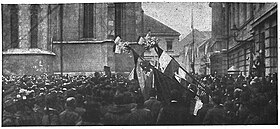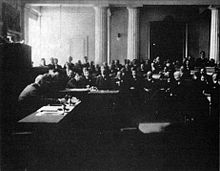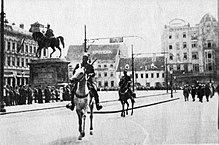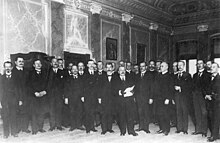A | B | C | D | E | F | G | H | CH | I | J | K | L | M | N | O | P | Q | R | S | T | U | V | W | X | Y | Z | 0 | 1 | 2 | 3 | 4 | 5 | 6 | 7 | 8 | 9
State of Slovenes, Croats and Serbs | |||||||||||||||||
|---|---|---|---|---|---|---|---|---|---|---|---|---|---|---|---|---|---|
| 1918 | |||||||||||||||||
 The State of Slovenes, Croats and Serbs in 1918. Istria was a disputed area, officially ceded to Italy by the Treaty of Rapallo. Southern Carinthia and Lower Styria were also disputed areas, with the Treaty of Saint-Germain demarcating the border of the newly-created Kingdom of Serbs, Croats and Slovenes with Austria. | |||||||||||||||||
| Status | Unrecognised provisional government seeking unification with Serbia | ||||||||||||||||
| Capital | Zagreb | ||||||||||||||||
| Common languages | |||||||||||||||||
| President of National Council | |||||||||||||||||
• 1918 | Anton Korošec | ||||||||||||||||
| Vice President | |||||||||||||||||
• 1918 | Ante Pavelić Sr. | ||||||||||||||||
• 1918 | Svetozar Pribićević | ||||||||||||||||
| Legislature | National Council of Slovenes, Croats and Serbs | ||||||||||||||||
| Historical era | Interwar period World War 1 | ||||||||||||||||
• Proclaimed secession | 29 October 1918 | ||||||||||||||||
1 December 1918 | |||||||||||||||||
| Population | |||||||||||||||||
• Estimate | 6,000,000 | ||||||||||||||||
| |||||||||||||||||
The State of Slovenes, Croats and Serbs (Serbo-Croatian: Država Slovenaca, Hrvata i Srba / Држава Словенаца, Хрвата и Срба; Slovene: Država Slovencev, Hrvatov in Srbov) was a political entity that was constituted in October 1918, at the end of World War I, by Slovenes, Croats and Serbs (Prečani) residing in what were the southernmost parts of the Austro-Hungarian Empire. Although internationally unrecognised, this was the first incarnation of a Yugoslav state founded on the Pan-Slavic ideology.[1] Thirty-three days after it was proclaimed, the state joined the Kingdom of Serbia and the Kingdom of Montenegro to form the Kingdom of Serbs, Croats and Slovenes.
Name
The state's name derives from the three main South Slavic ethnic groups that inhabited it: the Slovenes, Croats, and Serbs.
The Croats identified in the name were those residing in the preceding kingdoms of Croatia-Slavonia, Bosnia and Herzegovina and Dalmatia (including Boka Kotorska).
The Serbs identified in the name were those residing in Bosnia and Herzegovina, Croatia-Slavonia, Dalmatia (including Boka Kotorska and Montenegrin Littoral), not those residing in the Kingdom of Serbia (which included the territory of the present-day North Macedonia), nor those living in the Kingdom of Montenegro or Vojvodina (including Banat, Bačka, Baranya).[2][3]
The Slovenes identified in the name were the residents of the Duchy of Carniola, Duchy of Styria, Duchy of Carinthia and Prekmurje.
Creation
Background

In 1918, the final year of the War, the Austro-Hungarian monarchy was suffering from an internal crisis accompanied by unrest amongst the multiple Slavic peoples within its borders.[4] The South Slavic peoples were divided between various subdivisions of the monarchy:
- Cisleithania: The Austrian Littoral, Duchy of Carniola and the Kingdom of Dalmatia were under Austrian jurisdiction. The neighbouring duchies of Styria and the Carinthia also included a significant South Slavic population.
- Transleithania: The Kingdom of Croatia-Slavonia and Fiume (corpus separatum) were under Hungarian jurisdiction. The Kingdom of Hungary itself included a significant South Slavic populations in Prekmurje, Međimurje, Baranja and territories that had been part of the Voivodeship of Serbia and Banat of Temeschwar.
- The Austro-Hungarian Condominium of Bosnia and Herzegovina.
Activities of the pro-Yugoslav forces in the Transleithanian Kingdom of Croatia-Slavonia on 30 May 1917 resulted in adoption of the May Declaration by the Yugoslav Club, a group of Croatian and Slovene deputies in the Reichsrat (the legislature of Cisleithania in Vienna). The Declaration sought the unification of all the lands in the Habsburg monarchy populated by Slovenes, Croats, and Serbs in one independent entity.[5]
On 2–3 March 1918,[6] a grass-roots meeting was held in Zagreb that included representatives of various aspects of public life as well as members of several political parties, primarily the Mile Starčević faction of the Party of Rights led by Ante Pavelić and the Slovene People's Party.[7] The ruling Croat-Serb Coalition and its opposition the Croatian People's Peasant Party, however, were excluded. The meeting produced the Zagreb Resolution that proclaimed the unity of the people of Slovenes, Croats and Serbs (a "unified nation" with the latter described as equal "tribes" whose peculiar historical positions and desires are to be accommodated), demanded a right of self-determination and possession of the territory they occupied, including the whole of Cisleithania.[8]
In July and August 1918, the so-called "People's organizations of Slovenes, Croats and Serbs" were formed in Split (for Dalmatia), Sušak (for the Croatian Littoral) and Ljubljana (for the Slovene lands) to advance these policies. In late August, the Croatia-Slavonia parties met again in Zagreb to discuss how to proceed and, in particular, how to gain the support of the Croat-Serb Coalition.[9]
On 14 September 1918, Austro-Hungarian Foreign Minister Stephan Burián von Rajecz issued a statement advocating a settlement of World War I by peace treaty and it became apparent that the war was coming to an end. By early October, the Slovene-Croat-Serb movement were planning to set up a National Assembly. Svetozar Pribićević, the leader of the Croat-Serb Coalition, confronted Srđan Budisavljević, one of the leaders of this movement, in an effort to determine whether these plans were meant to undermine the Coalition, and the two reached an understanding whereby the Coalition would be invited to join any future National Council before a National Assembly was formed. At the same time, the organizers obtained support from the Croatian People's Peasant Party and the Serb People's Radical Party. On 5 and 6 October, a provisional assembly was convened and the formation of executive committees begun. Seats were apportioned to members of all parties,[7] but not without acrimony over the ad hoc nature of the proceedings.[10]
Establishment


The People's Council (Serbo-Croatian: Narodno vijeće, Slovene: Narodni svet) was established on 5–8 October 1918 in Zagreb, pursuant to the decisions reached in March 1918. The Council declared itself a political representative body of Slovenes, Croats and Serbs living in Croatia-Slavonia, Fiume, Dalmatia, Bosnia and Herzegovina, Istria, Trieste, Carniola, Gorizia and Gradisca, Styria, Carinthia, Bačka, Banat, Baranya, Međimurje and elsewhere in southwest Hungary. The Council established its own Central Committee and Presidency, while one member of the Council was to be representative of a 100,000 people. In addition, it comprised five representatives of Croatian Sabor, the Diet of Bosnia and Reichsrat for a total of 95 representatives. 32 voting members were required to form the quorum, and two-thirds majority was needed for any decisions. Members of regional parliaments were allowed to attend as non-voting observers. The Council elected up to 30 Central Committee members, who could appoint a further 10 to the committee by a two-thirds vote.[6]
The Kingdom of Hungary signed a truce with the Allies on 13 October 1918. Pavelić and others started negotiating with the Serbian envoy to the National Assembly Dušan T. Simović as soon as Simović had said that their military victory and the treaty with Hungary gave them right to most of the territory of the State of Slovenes, Croats and Serbs, whereas Pavelić said that they want unification with Serbia, but that they needed a federal state as well as a delineation of Croatian and Serbian population that would assume a population transfer. Simović rejected the talk of federalization and Pavelić yielded, and there was no further discussion on either issue.[11]
On 14 October 1918, Austrian foreign minister Burián asked for an armistice based on the Fourteen Points outlined in January 1918 by American president Woodrow Wilson, whose Point 10 read: "The people of Austria-Hungary, whose place among the nations we wish to see safeguarded and assured, should be accorded the freest opportunity to autonomous development." Two days later, Emperor Karl issued a proclamation ("Imperial Manifesto of 16 October 1918"), which envisaged a significant modification the structure of the Empire by granting wide autonomy to its peoples, including federalization of Cisleithania.[12] Karl's proposal was rejected on 18 October by U.S. Secretary of State Robert Lansing who said autonomy for the nationalities was no longer enough. On 19 October, the National Council of Slovenes, Croats and Serbs declared itself the supreme representative body of all South-Slavic peoples in the monarchy.[6]
On 21 and 22 October, members of the Pure Party of Rights who still advocated a trialist monarchy secured formal support for a trialist manifesto from Emperor Karl and Prime Minister Sándor Wekerle in Hungary, but the latter was deposed the next day.
Numerous mass rallies were held in Zagreb in support the Yugoslav cause, especially on 22 October.


On 28 October, Gyula Andrássy the Younger sent a peace note to the American government while the Ban of Croatia, Antun Mihalović, reported to the Emperor and was dismissed with the instruction "Do as you please".[13] The Ministry of War had also decided to allow the local military commands to approach the people's councils in order to help maintain law and order. All this was taken as a sign that the Austro-Hungarian monarchy was disintegrating and that the State of Slovenes, Croats and Serbs was an attainable goal.[14]
The state was proclaimed officially on 29 October 1918. Its first president was a Slovene, Anton Korošec. The two vice presidents were a Serb, Svetozar Pribićević, and a Croat, Ante Pavelić.[6]
The new state aspired to include all those territories of the former Austria-Hungary that were inhabited by Slovenes, Croats and Serbs. Those representing the Serbs in Vojvodina, however – including those in Banat, Bačka and Baranja – objected and formed their own administration under the supreme authority of the Serbian National Board in Novi Sad. Vojvodina then joined the Kingdom of Serbia on 25 November 1918. One day earlier, on 24 November 1918, the region of Syrmia, which had become part of the State of Slovenes, Croats and Serbs, seceded and also joined the Kingdom of Serbia.[2][3]
Conflict with Italy
In order to avoid handing them to the Entente Powers, Emperor Karl assigned the entire Austro-Hungarian Navy, the Austro-Hungarian merchant fleet and all Austro-Hungarian harbours, arsenals and shore fortifications to the National Council. The National Council sent diplomatic notes to the Entente governments notifying them that they had taken control of these assets and were not at war. The fleet, however, was soon attacked and dismembered by the Italian navy, the Regia Marina.
Austria-Hungary reached an armistice with Italy through the Armistice of Villa Giusti signed on 4 November 1918. This agreement stipulated that Italy could occupy large parts of the territory that had been included in the State of Slovenes, Croats and Serbs. Italian troops then occupied Istria and much of Dalmatia and remained there until 1921, when the Treaty of Rapallo came into effect.
Creation of the Kingdom of Serbs, Croats, and Slovenes


The State of Slovenes, Croats and Serbs did not obtain international diplomatic recognition before it ceased to exist. In a note of 31 October, the National Council informed the governments of the United Kingdom, France, Italy and the United States that the State of Slovenes, Croats and Serbs was constituted in the South-Slavic areas that had been part of Austria-Hungary, and that the new state intended to form a common state with Serbia and Montenegro. The same note was sent to the government of the Kingdom of Serbia and the Yugoslav Committee in London. Serbia's prime minister Nikola Pašić responded to the note on 8 November, recognizing the National Council in Zagreb as "legal government of Serbs, Croats and Slovenes living in the territory of the Austria-Hungary", and notified the governments of the United Kingdom, France, Italy and the United States asking them to do the same.
On 23–24 November, the National Council declared "unification of the State of Slovenes, Croats and Serbs formed on the entire, contiguous South-Slavic area of the former Austria-Hungary with the Kingdom of Serbia and Montenegro into a unified State of Slovenes, Croats and Serbs". 28 members of the council were appointed to implement that decision based on National Council's adopted directions on implementation of the agreement of organization of the unified state with the government of the Kingdom of Serbia and representatives of political parties in Serbia and Montenegro. The instructions were largely ignored by the delegation members who negotiated with Regent Alexander instead.[6]
Stjepan Radić's Peasant Party participated in the National Council, but after it decided to merge with Serbia, they started to back off, calling the move foolish, and disputing the decision based on the fact that the Croatian Parliament never explicitly approved it.[15]
On 1 December, Regent Alexander proclaimed unification of "Serbia with lands of the independent State of Slovenes, Croats and Serbs into a unified Kingdom of Serbs, Croats, and Slovenes". As the National Council ceased to operate, it never formally ratified the proclamation, nor did the Parliament of Serbia, which took note of the declaration on 29 December 1918.[6]
The National Council's final important task was to appoint representatives to the Temporary National Representation in early 1919.[16]
See also
- Geneva Declaration (1918)
- Lipošćak affair
- Podgorica Assembly
- History of Yugoslavia
- Verigar issue
- Slovene March
- Timeline of Croatian history
References
- ^ Mitrović, Andrej (2007). "Serbia's Great War, 1914–1918". London: Hurst & Company. Archived from the original (PDF) on 3 March 2012. Retrieved 15 November 2010.
- ^ a b (in Serbian) Vladimir Ćorović, Ilustrovana istorija Srba (knjiga šesta), Belgrade, 2006.
- ^ a b (in Serbian) Drago Njegovan, Prisajedinjenje Vojvodine Srbiji, Novi Sad, 2004.
- ^ Matijević 2008, p. 36.
- ^ "Svibanjska deklaracija | Hrvatska enciklopedija". enciklopedija.hr.
- ^ a b c d e f Boban 1993
- ^ a b Štambuk-Škalić & Matijević 2008
- ^ Matijević 2008, p. 43.
- ^ Matijević 2008, pp. 44–45.
- ^ Matijević 2008, p. 45-48.
- ^ Matijević 2008, p. 61.
- ^ Matijević 2008, p. 48.
- ^ Matijević 2008, p. 50.
- ^ Matijević 2008, pp. 50–51.
- ^ "Povijest HSS-a" (PDF) (in Croatian). Croatian Peasant Party. p. 10. Archived from the original (PDF) on 7 April 2013.
24. studenog – Govor Stjepana Radića na sjednici središnjeg odbora Narodnog vijeća SHS – Gospodo! Još nije prekasno! Ne srljajte kao guske u maglu. 1. prosinca 1918. Adresa delegacije Narodnog vijeća SHS regentu Aleksandru i proglašenje nove države Kraljevstva Srba, Hrvata i Slovenaca. Ulazak Hrvatske u ovu državnu tvorevinu Hrvatski sabor nije odobrio ni potvrdio, na što je opetovano ukazivao Stjepan Radić, osporavajući na taj način njezin legitimitet. 31. prosinca u DOM-u objavljen članak S. Radića Republika ili slobodna narodna država konstituanta ili narodni revolucionarni sabor.
- ^ Matijević 2008, p. 66.
Sources
- Matijević, Zlatko (November 2008). "Narodno vijeće Slovenaca, Hrvata i Srba u Zagrebu: Osnutak, djelovanje i nestanak (1918/1919)" (PDF). Fontes (in Croatian). 14 (14). Croatian State Archives: 35–66. ISSN 1330-6804.
- Štambuk-Škalić, Marina; Matijević, Zlatko, eds. (November 2008). "Narodno vijeće Slovenaca, Hrvata i Srba u Zagrebu 1918–1919. Izabrani dokumenti". Fontes (in Croatian). 14 (1). Croatian State Archives: 71–596. Retrieved 8 December 2010.
- Boban, Ljubo (October 1993). "Kada je i kako nastala Država Slovenaca, Hrvata i Srba" [When and how was the State of Slovenes, Croats and Serbs formed]. Radovi – Journal – Institute of Croatian History (in Croatian). 26 (1). Institute of Croatian History, Faculty of Philosophy, Zagreb: 187–198. ISSN 0353-295X. Retrieved 16 December 2012.
External links
- Država Slovenaca, Hrvata i Srba (1918) (in Croatian)
- Map Archived 5 December 2012 at archive.today
>Text je dostupný pod licencí Creative Commons Uveďte autora – Zachovejte licenci, případně za dalších podmínek. Podrobnosti naleznete na stránce Podmínky užití.
Slovene language
Croatian language
Serbian language
File:Flag of the State of Slovenes, Croats and Serbs.svg
File:Coat of arms of Croatia (State of Slovenes, Croats and Serbs).svg
File:State of Slovenes Croats and Serbs.png
Istria
Treaty of Rapallo (1920)
Carinthia
Lower Styria
Treaty of Saint-Germain
Kingdom of Serbs, Croats and Slovenes
List of states with limited recognition
Provisional government
Kingdom of Serbia
Zagreb
Serbo-Croatian
Slovene language
Anton Korošec
Ante Pavelić (1869–1938)
Svetozar Pribićević
National Council of Slovenes, Croats and Serbs
Interwar period
World War 1
Secession
Kingdom of Serbs, Croats and Slovenes
Austro-Hungarian rule in Bosnia and Herzegovina
Kingdom of Croatia-Slavonia
Duchy of Carniola
Kingdom of Dalmatia
Kingdom of Serbs, Croats and Slovenes
Kingdom of Italy
Serbo-Croatian language
Slovene language
World War I
Slovenes
Croats
Serbs
Prečani (Serbs)
Austria-Hungary
List of states with limited recognition
Yugoslavia
Pan-Slavism
Kingdom of Serbia
Kingdom of Montenegro
Kingdom of Serbs, Croats and Slovenes
South Slavs
Ethnic group
Slovenes
Croats
Serbs
Kingdom of Croatia-Slavonia
Condominium of Bosnia and Herzegovina
Kingdom of Dalmatia
Boka Kotorska
Condominium of Bosnia and Herzegovina
Kingdom of Dalmatia
Boka Kotorska
Montenegrin Littoral
Kingdom of Serbia
Republic of North Macedonia
Kingdom of Montenegro
Vojvodina
Banat
Bačka
Baranya (region)
Duchy of Carniola
Duchy of Styria
Duchy of Carinthia
Prekmurje
Corfu Declaration
File:Austria hungary 1911.jpg
William R. Shepherd
South Slavic peoples
Cisleithania
Austrian Littoral
Duchy of Carniola
Kingdom of Dalmatia
Duchy of Styria
Duchy of Carinthia
Transleithania
Kingdom of Croatia-Slavonia
Corpus separatum (Fiume)
Kingdom of Hungary
Prekmurje
Međimurje
Baranya (region)
Voivodeship of Serbia and Banat of Temeschwar
Austro-Hungarian Condominium of Bosnia and Herzegovina
Lands of the Crown of Saint Stephen
Kingdom of Croatia-Slavonia
May Declaration
Imperial Council (Austria)
Zagreb
Mile Starčević (politician, born 1862)
Party of Rights
Ante Pavelić (1869–1938)
Slovene People's Party (historical)
Croat-Serb Coalition
Croatian People's Peasant Party
Zagreb Resolution
Self-determination
Split (city)
Sušak, Rijeka
Croatian Littoral
Ljubljana
Slovene lands
Croat-Serb Coalition
Foreign Ministry of Austria-Hungary
Stephan Burián von Rajecz
Svetozar Pribićević
Srđan Budisavljević
Serb People's Radical Party
Ad hoc
File:SHS slavlje 1918.jpg
Zagreb
National Council of Slovenes, Croats and Serbs
File:StampYugoslavia1918Michel51.jpg
Postage stamp
Croatia
Serbo-Croatian language
Slovene language
Istria
Trieste
Carniola
Princely County of Gorizia and Gradisca
Duchy of Styria
Duchy of Carinthia
Bačka
Banat
Baranya (region)
Međimurje
Sabor
Diet of Bosnia
Quorum
Kingdom of Hungary
Allies of World War I
Dušan T. Simović
Kingdom of Serbia
Population transfer
Fourteen Points
Woodrow Wilson
Self-determination
Charles I of Austria
Federalization
Robert Lansing
National Council of Slovenes, Croats and Serbs
Pure Party of Rights
Trialism in Austria-Hungary
Sándor Wekerle
File:Session of Sabor.jpg
Sabor
File:KongressfallofAH.jpg
Congress Square
Ljubljana
Gyula Andrássy the Younger
Ban of Croatia
Antun Mihalović
Anton Korošec
Svetozar Pribićević
Ante Pavelić (politician born 1869)
Austria-Hungary
History and culture of Serbs in Vojvodina
Banat, Bačka and Baranja
Serbian National Board
Novi Sad
Kingdom of Serbia
Syrmia
Adriatic Question
Allies of World War I
Austro-Hungarian Navy
Regia Marina
Armistice of Villa Giusti
Treaty of Rapallo, 1920
Creation of Yugoslavia
File:Serbian Army enters Zagreb.jpg
Royal Serbian Army
Zagreb
Ban Jelačić Square
File:SHS 1918 adresa Aleksandru.jpg
Ante Pavelić (1869–1938)
Diplomatic recognition
United Kingdom
French Third Republic
Kingdom of Italy
United States
Kingdom of Serbia
Nikola Pašić
Alexander I of Yugoslavia
Stjepan Radić
Kingdom of Serbs, Croats, and Slovenes
Temporary National Representation
Geneva Declaration (1918)
Lipošćak affair
Podgorica Assembly
History of Yugoslavia
Verigar issue
Slovene March (Kingdom of Hungary)
Timeline of Croatian history
Vladimir Ćorović
Croatian Peasant Party
Croatian State Archives
ISSN (identifier)
Ljubo Boban
Faculty of Philosophy, Zagreb
ISSN (identifier)
Category:State of Slovenes, Croats and Serbs
Archive.today
Template:Croatia topics
Template talk:Croatia topics
Special:EditPage/Template:Croatia topics
Croatia
Index of Croatia-related articles
History of Croatia
History of Croatia before the Croats
Origin hypotheses of the Croats
White Croats
White Croatia
Duchy of Croatia
Dalmatian city-states
Slavs in Lower Pannonia
Red Croatia
Narentines
Zachlumia
Travunia
Kanalites
Kingdom of Croatia (925–1102)
Ban of Croatia
Ban of Slavonia
Croatia in personal union with Hungary
Venetian Dalmatia
Republic of Ragusa
Kingdom of Croatia (Habsburg)
Illyrian Provinces
Kingdom of Croatia-Slavonia
Kingdom of Yugoslavia
Banovina of Croatia
World War II in Yugoslavia
Independent State of Croatia
Socialist Republic of Croatia
Independence of Croatia
Croatian War of Independence
History of Croatia (1995–present)
Croatia–NATO relations
2013 enlargement of the European Union
File:Coat of arms of Croatia.svg
Geography of Croatia
Geography of Croatia#Climate
List of extreme points of Croatia
List of islands of Croatia
List of lakes of Croatia
List of mammals of Croatia
List of mountains in Croatia
List of protected areas of Croatia
List of rivers of Croatia
Topography of Croatia
Politics of Croatia
Administrative divisions of Croatia
Constitution of Croatia
President of Croatia
Government of Croatia
Prime Minister of Croatia
Human rights in Croatia
LGBT rights in Croatia
Law enforcement in Croatia
Armed Forces of Croatia
General Staff of the Armed Forces (Croatia)
Chief of the General Staff of the Armed Forces (Croatia)
Croatian Parliament
Speaker of the Croatian Parliament
List of political parties in Croatia
Elections in Croatia
Foreign relations of Croatia
Croatian security and intelligence system
Economy of Croatia
Croatian brands
Energy in Croatia
List of Croatian counties by GDP
Industry of Croatia
History of Croatian currency
Croatian National Bank
Croatia and the euro
Privatization in Croatia
Zagreb Stock Exchange
Telecommunications in Croatia
Tourism in Croatia
Transport in Croatia
Category:Society of Croatia
Croats
Demographics of Croatia
Education in Croatia
Category:Ethnic groups in Croatia
Genetic studies on Croats
Healthcare in Croatia
Demographics of Croatia#Languages
Religion in Croatia
Women in Croatia
Culture of Croatia
Architecture of Croatia
Croatian art
Cinema of Croatia
Croatian cuisine
Croatian wine
Croatian language
Croatian literature
Music of Croatia
Public holidays in Croatia
List of radio stations in Croatia
Sport in Croatia
Television in Croatia
List of World Heritage Sites in Croatia
National symbols of Croatia
Lijepa naša domovino
Croatian checkerboard
Coat of arms of Croatia
Croatian national costume
Crown of Zvonimir
Orders, decorations, and medals of Croatia
Updating...x
Text je dostupný za podmienok Creative
Commons Attribution/Share-Alike License 3.0 Unported; prípadne za ďalších
podmienok.
Podrobnejšie informácie nájdete na stránke Podmienky
použitia.




